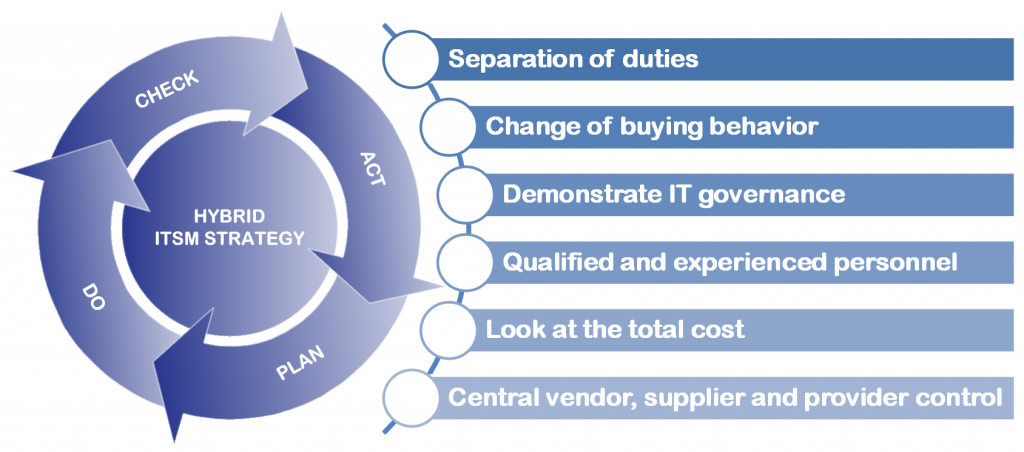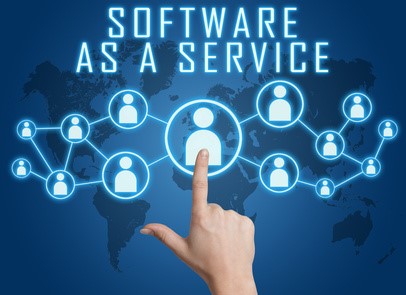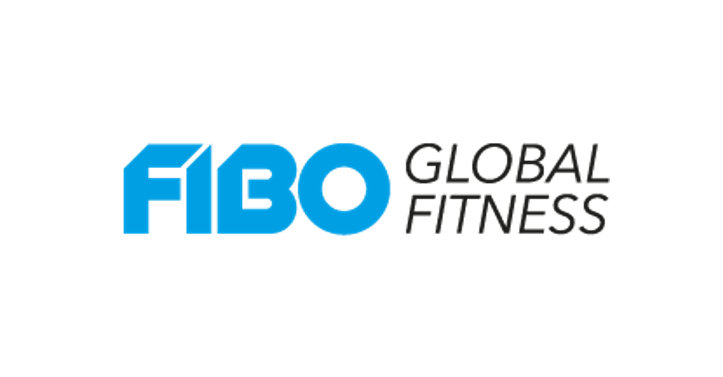Many companies use a variety of cloud solutions or they are thinking about using cloud solutions as part of their strategy. This is true especially in the area of IT Service Management (ITSM) because they see a huge potential to deploy a cloud-based service desk.
But aspects like compliance, privacy policies, ISO standards or legal provisions prohibit innovation, quality intensification and IT cost reduction. They feel restricted from accomplishing the promises of cloud.
In order to find the right strategy and identify the right ITSM delivery model, take a look at the use cases:
- Deploy an on-premise ITSM in your own IT data center
- Procure a Software-as-a-Service (SaaS) ITSM solution from the cloud
- Use a combination of a SaaS-based and an on-premise ITSM solution
The latter, also known as a hybrid ITSM solution, is often preferred because it combines the best of both worlds in terms of innovation and quality—with regard to the services you deliver and support. Keep in mind that the final decision on the other type of model used in this situation depends on the details of your use scenarios and requirements.
When deciding to use a hybrid model it is important to look for a solution that operates in a standardized and harmonized manner. With HP Service Manager and HP Service Anywhere this hybrid ITSM strategy can be homogeneously and successfully implemented. (now in the Microfocus Familiy)
Both solutions leverage and embed the HP Haven Big Data platform to use the power of Big Data in the service desk. One of the resulting capabilities in Service Manager service desk software, Smart Ticket, allows you to analyze screenshots, and automatically open and classify incidents based on the screenshot content. Hot Topic Analytics detects trends and patterns within data like incidents—to increase the service desk’s efficiency.
A hybrid ITSM solution with HP Software / Microfocus
A successful ITSM hybrid solution implementation—including multiple customer and multiple supplier management—needs a holistic approach. The approach should reflect the company-specific background and requirements in order to grow with the organizational structure when time comes. To become a better service provider, IT organizations should be flexible, effective and efficient to align their IT strategy as demanded by trends, customers and the business. With the scalable ITSM hybrid solution approach, based on HP Software, these plans and objectives can be implemented consecutively.
Multiple vendors, suppliers, providers and lines of business can be integrated upstream via HP Service Anywhere SaaS-based ITIL service desk. With this integration, they become an integral part of all processes and workflows and are able to deliver and support services based on agreed service levels, and controlled by overall service level management.
Advantages of a hybrid ITSM solution include: high scalability, flexible use and licensing—dependent on the particular use case, effort and cost.
A sample use case
Imagine that because of a business expansion, a subsidiary or department is planning a comprehensive rollout. The rollout requires additional infrastructure, server and client support for the time of the rollout and an agreed on transition period. For this purpose, HP Service Anywhere can be supplied to an additional number of users to provide support for requests, incidents, problems and changes during the runtime of the project. After project completion, important data like incident, problem and change records can be transferred to the central HP Service Manager instance to meet audit needs. Further, the SaaS-based model allows for increases and decreases in licenses due to the changing demands after project completion.
Integrating end customers
End customers can be integrated using the same approach. If these customers require capabilities going beyond standard self-service portal and catalog services, an extended service desk can be offered to them. Again, based on HP Service Anywhere, these customers can be integrated by providing access to the SaaS-service desk. The design and process of the service(s) delivered by the IT organization are crucial in this case for the interface between customer and IT, while the customer retains the full flexibility for the implementation based on the processes at their end.
In the case of a service disruption, for example, the ticket can be assigned to a specific user group. A routing process then can decide, whether the ticket stays with the customer or if the ticket is forwarded to the central IT (Service Manager). Another advantage of this hybrid approach is that the customer can use the collaborative and intelligent search mechanisms of Service Anywhere to find related information like a solution to the problem, a manual or knowledge articles.
Mandanten Security?
Thinking about mandanten protection in the above use case, reveals another benefit of the hybrid ITSM solution for the IT organization. There is no need to implement complex mandanten structures, filter rules and reporting – the license and access determine who can access what capabilities and what is being tracked.
Agility – adapt to different strategies fast
The above shows that the hybrid ITSM solution based on HP Service Manager for central IT and one or more instances of HP Service Anywhere allows users to implement different IT strategies in a very agile way. At the same time it allows users to:
- Control costs
- React quickly to changing demands
- Improve customer satisfaction
6 tips for multi-customer and provider management

Both Service Manager and Service Anywhere fulfill all key pre-requisites for the technical implementation of the outlined hybrid ITSM solution. Both products are strictly aligned with ITIL ® best practices, have a similar look and feel as well as usability interface. The key challenges lie within the professional transformation to and management of a multi-customer and provider management strategy and its implementation. The key to this implementation is to always have flexibility in mind. According to my experience, the following aspects need to be considered to successfully reach the given objectives.
1. Separation of duties
A clear separation of tasks and scopes between all providers and the multi-customer and provider management is key. Providers need to know and understand their areas of responsibility so that all tasks are executed by their respective owners and no tasks are left undone. This avoids finger pointing and drawn out discussions and encourages problem resolution between all involved parties. Separation also needs to be reflected in the tickets if incident management is not strictly separated between providers.
2. Change of buying behavior
Departments and lines of business must not order IT services without involving multi-customer and provider management. Otherwise, businesses – especially in highly regulated areas like the financial industry – run the risk of potentially losing control. As a result, the peril of outsourcing cannot be clearly assessed. Compared to conventional IT outsourcing, multi-customer and provider management for cloud service providers need to integrate new and more stringent control mechanism and contracts.
3. Demonstrate IT governance
The required interlocking of governance controls with the provider is probably one of the biggest challenges with any sourcing strategy. This includes: central contract, risk and service level management on the customer side for example. Interlocking governance controls avoids problems at the interface and within processes can be resolved efficiently. Along with a clearly defined reporting strategy and implementation this lowers risk and enables to demonstrate strong IT governance. COBIT controls built upon ITIL processes can help with this.
4. Qualified and experienced personnel
Having qualified and experienced personnel is essential for the planning process (outsourcing, contract management etc.) as well as for the long-term sourcing. External consultants can help with building this knowledge and the required personnel.
5. Look at the total cost
It is important to include all costs right from the beginning. When looking at the cost saving associated with outsourcing to multiple providers, do not forget about the additional cost resulting from multi-customer and provider management. New roles and responsibilities increase costs, and missing or wrong controls can lead to substantial follow-up cost.
6. Central vendor, supplier and provider control
Having a centralized system requires defined roles and processes, on the tactical and operational level. The management effort is higher compared to a single-sourcing strategy and demands for an open communication climate between all involved parties. ITIL provides the means so that all tools talk the same “language”. Constant intercommunication between vendor, supplier, provider and the outsourcing company is vital to the success of everyone involved.
Conclusion
It depends on the particular business goals and objectives whether a single- or multi-sourcing strategy is the right direction for your organization. IT organizations cannot make such an important decision on their own; departments and lines of business need to be integrated into the decision making process.
Cost savings is a result from a single-vendor-supplier-provider strategy or increased quality with a targeted multi-vendor-supplier-provider approach. Business aspects are important to keep in mind during this decision. You need to make sure you keep the risks related to the transition and integration at the top of your mind. But there is one final factor that may sway your decision. A lack of cooperation between vendors, suppliers and providers can – dependent on the level of control – argue for one or the other strategy.
Orignal Post @ http://h30499.www3.hp.com/t5/IT-Service-Management-Blog/6-Tips-for-a-successful-hybrid-ITSM-strategy/ba-p/6731962#.VZ6WzfntlBc




